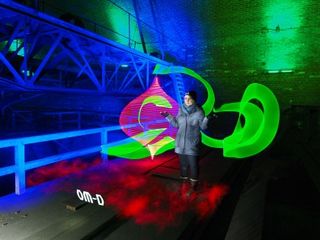Why you can trust TechRadar
Olympus has improved upon the E-M5's video recording capability, and there are a number of features on the E-M5 Mark II to catch the attention of videographers. The compression settings allow footage to be recorded in MOV(MPEG-4AVC/H.264) or AVI(Motion JPEG) format, with bitrates up to 77 Mbps allowing greater scope for post-production processing. As well as having frame rate options of 50, 30, 25 and 24fps, you can record 1080p footage at 60fps which can be converted to 24fps in post production for high resolution slow motion playback. Further good news is that the image stabilisation system operates during movie recording, which should result in smoother hand-held footage.

There's also a 3.5mm microphone socket and the ability to manually control the input level, so it's possible to record useable audio via a hot-shoe mounted microphone. If you want to monitor audio via headphones, however, you'll need to use the optional HLD-G8 grip because the camera body itself doesn't have a port.
In addition, you can send clean output to an external monitor or recorder via the a Micro HMDI port (Type D), and Time Code is also available with Rec Run and Free Run allowing you to specify if the camera records the time code only when recording is taking place, or the whole time including when recording is stopped – useful when editing footage from multiple cameras.
Exposure innovations
Exposure measurement is courtesy of the 324 zone Multi-pattern metering system which offers the general-purpose ESP light metering mode along with the usual Centre-weighted and Spot metering options. Olympus's unique Highlight and Shadow spot metering options are also available allowing you to take measurements from the brightest or darkest parts of the scene and ensure they are recorded accordingly rather than rendered a mid-tone.
In addition, sensitivity may be set in the native range ISO 200-25,600 with extension settings pushing this to 100-25,600. When the standard mechanical shutter is used, shutter speed can be set at up to 1/8000sec, which is useful for shooting with large apertures (to restrict depth of field) in very bright light, and for as long as 60 seconds. Bulb mode allows exposures of up to 30 minutes. When the electronic shutter is used for silent shooting, the available shutter speed range changes to 1/16,000-60sec.
Live Bulb and Live Time mode are both present along with Live Composite mode, which was introduced with the Olympus E-M10. In Live Bulb mode the shutter stays open for as long as the shutter release is held down while in Live Time mode, the shutter is opened with a press of the shutter release and it stays open until it is pressed again. The clever bit is that the image can be seen building up on the camera's screen, or on the screen of a smartphone or tablet connected via a Wi-Fi connection. This enables the exposure to be assessed and the shutter closed when the image looks right.

Live Composite mode works in a similar way, but it's specifically intended for use when shooting fireworks, star trails or when painting with light. It works by first taking a reference image of the scene with the first press of the shutter release. Then, once the camera says that it's ready, a second press opens the shutter for a second time. If the scene doesn't change the image on the screen looks the same as the reference shot, but if lighter elements such as fireworks or light trails appear they will be seen building-up on-screen. Once the image looks correct, the shutter is closed with a third press of the shutter release.
Although Olympus has improved upon the 35-point contrast detection system of the original E-M5 by giving the Mark II the 81-point system found in the E-M10, it hasn't gone as far as giving it the hybrid AF system of the E-M1.
With the possible exception of the lack of a pop-up flash unit, the OM-D E-M5 Mark II has a comprehensive specification and provides the enthusiast photographer with just about everything they could want. It also has plenty to entice aspiring videographers looking for a more affordable camera than the popular Canon 5D Mark III or dedicated, professional-level video camera.
Current page: Video and exposure innovations
Prev Page Introduction and features Next Page Build and handling
